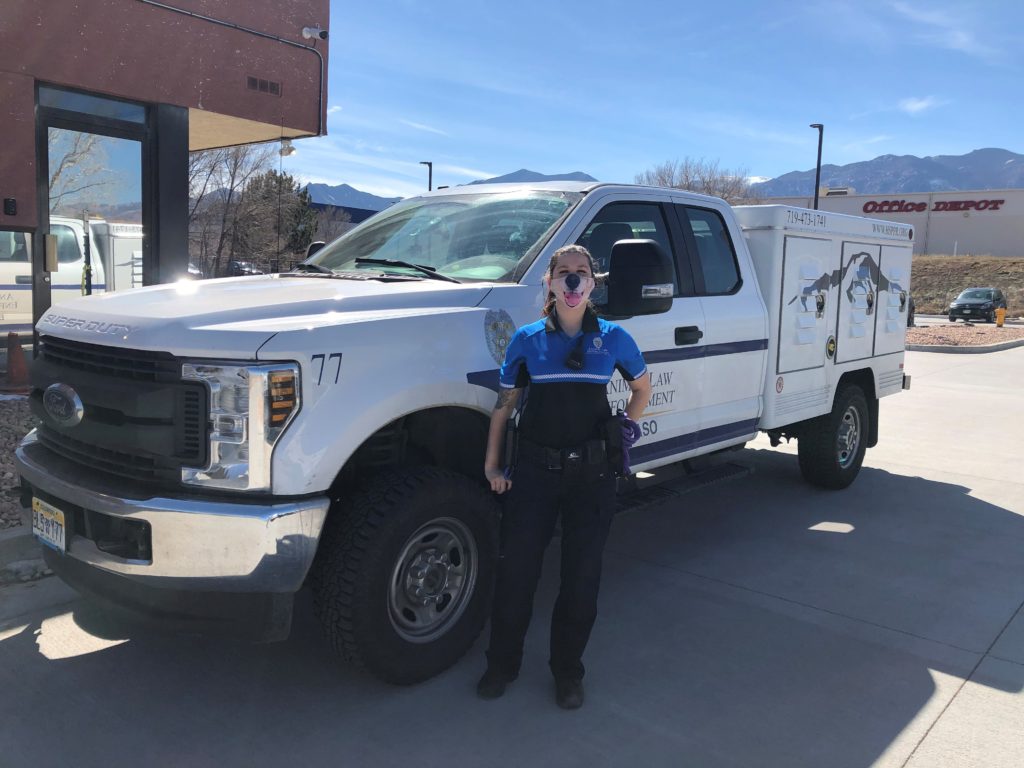
Corporal Rebekah Ellis, HSPPR Animal Law Enforcement badge number 313, stands 5’3” tall and weighs 120 pounds. She drives truck number 77 and was in the old truck number 77 before that. She has a soft spot for the homeless community and their pets. And her favorite place to go with her dog Bjorn is Pub Dog. In short, she’s a real person doing a tough job – keeping the pets and people of El Paso County safe!
This week is Animal Control Appreciation Week, so we joined Corporal Ellis on a ride-along to find out the complicated ins and outs of this complex, sometimes misunderstood profession.
At 11:15 sharp, we hopped in Truck 77 to begin our ride-along with the officer of the hour herself. Corporal Ellis has worked at HSPPR for three years now. She was hired in January of 2018, and she’s been a dedicated protector of pets and people alike since that time.
Before we are even out of the parking lot, we get a priority call that someone has seen a dog, possibly hit by a car, limping close by. Instead of pursuing the follow up case we were headed for, we turn toward an area just south of downtown to search for this potentially injured dog.
Before she became an ALE officer at HSPPR, Corporal Ellis went to Pima and trained to be a veterinary assistant.
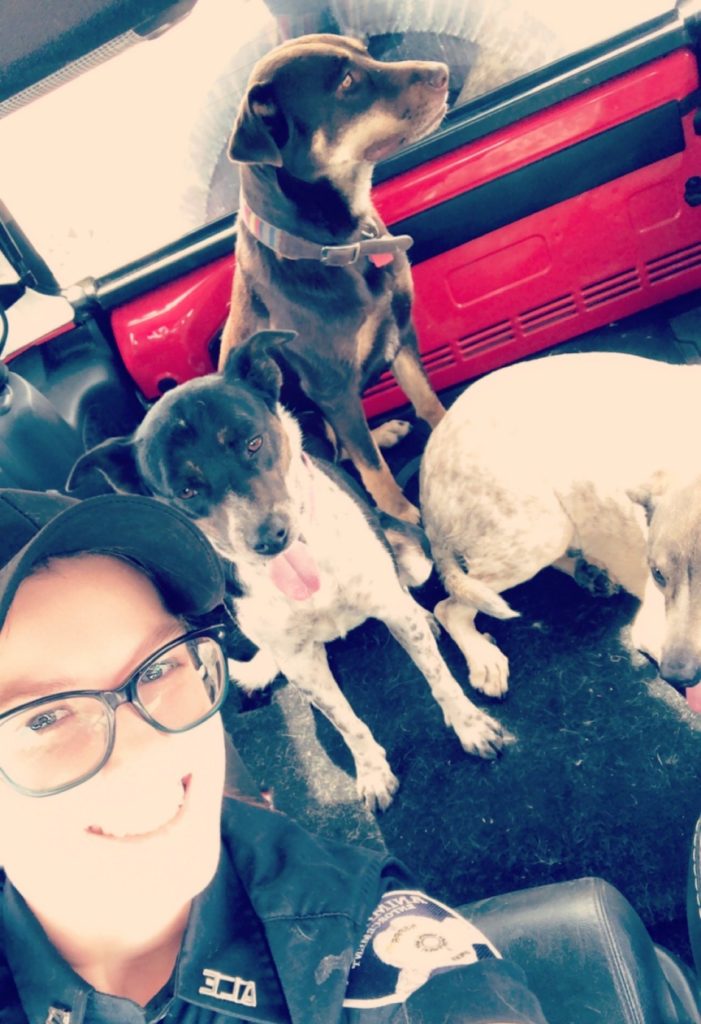
“That training helps me so much with the animals that have been hurt,” Corporal Ellis said. “I know what to look for as far as shock and injuries go. I did have a situation recently where a dog was attacked by a housemate. I took his heart rate, breath rate, and capillary refill time. He was in shock, but I was able to relay that to his owners, that you need to take him to the vet now, and we were able to immediately get him the help he needed.”
When she was growing up, Corporal Ellis wanted to be a forensic scientist. She also grew up watching Animal Cop Houston. In this job, she puts her associate degree and lots of criminology classes, plus her veterinary medicine experience, to good use!
“This is a very competitive field to get into,” Corporal Ellis said. “I applied four times before being accepted into the Animal Law Enforcement Academy. But this is my dream job. I can’t imagine doing anything else.”
In this case, we were headed out to set up a patrol to see if we could bring that potentially injured dog to safety. Corporal Ellis says patrols are their most common type of call. “There’s always a dog at large,” Corporal Ellis says with a laugh. “It’s job security.” So those dog catcher comments aren’t completely unwarranted… But Corporal Ellis says her favorite types of calls are potentially aggressive animals.
“It’s an adrenaline rush, especially with those large dog breeds,” she said. “You never know what you’re going into. That dog could be aggressive with humans, it could be scared or fearful, it’s never a typical day to be honest. You never know what you are going to get. That’s my favorite part, not only because of the adrenaline rush, but once you remove that dog out of the environment, it changes. Once it’s not scared or stimulated, you can see his whole demeanor change, and he will become the friendliest dog you’ll ever know. I love being there to help calm these dogs down and get the help they need in each situation.”
It sounds strange, but Corporal Ellis’ second favorite types of calls are hoarding situations. “I like hoarding calls!” Corporal Ellis says. “It can get gross and nasty, but you’ve got cats bouncing off the walls, coming out of all the cabinets, it’s chaotic and crazy, but it’s a lot of fun. Plus, you know you are getting those kitties into a better situation, and you get to be the one there to calm them down and help them.”
But Ellis admits it’s not all fun and games. “A lot of people think we play with puppies and kittens all day, but we see a lot of hard stuff, especially with cruelty cases. You have to have good compartmentalization. We do respond to calls with dead bodies, and you have to be able to – I wouldn’t say ignore it – but compartmentalize it.”
She pauses to verify with dispatch the direction the dog was headed. We’ve been driving for about ten minutes in the area, and we still haven’t seen any sign of the injured dog.
“That surprised me most when I took this job, how people treat their animals,” she continues. “It’s not always the owner’s fault, but a lot of people don’t realize. Your dog is limping, but it’s not going to communicate like a human. You have to educate them, tell them to take their animal to the vet. Or the mentality of people who abuse their animals. To me, animals are family, and I don’t see how people can do that to their family member.”
Still no sign of the dog. It’s been about 15 minutes of driving around now. Corporal Ellis says that’s about the standard amount of time they will patrol for a dog at large. “If we don’t see it, unfortunately, we can’t spend all day looking. There’s a high probability someone has picked him up or it went back home.”
“That’s another hard thing,” she continues. “Now, in my mind, I’m going to keep thinking, what if it didn’t get help? What if it’s laying somewhere where I didn’t see it? You have to hope someone picked up the dog. I try not to focus on the bad all the time because if you do, you are going to drive yourself crazy.”
“Clear,” she says into her radio, indicating we are closing out this patrol and headed to our original destination. This time, we’re following up on a possible case of abandonment. The only info we have is that, allegedly, no one has come by to feed or water dogs in an apartment.
On the way, we talk about the training Ellis received during her time at the HSPPR ALE Academy. Phase 1 training (basic officer) is 125.5 hours of classroom time and then 120 hours of OTR (On The Road training with a trainer) before they are released out on their own to do the basic animal control type calls.
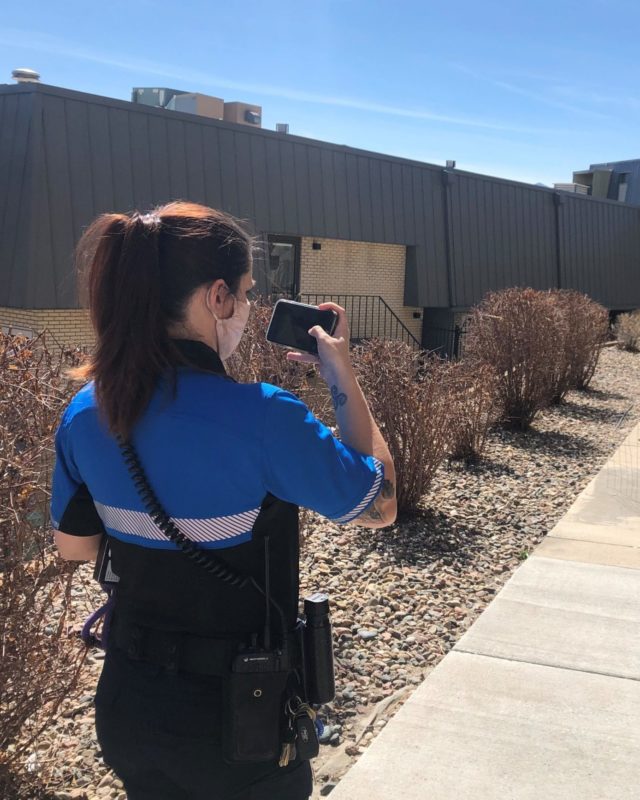
Phase 2 training (Level II Officer, which is an investigating officer) is an additional 28.5 hours of classroom training and an additional 80 hours of OTR training. Their trainer will assess them and determine if they are approved to progress to Level II Officer.
In this training, Ellis says aspiring officers learn everything from how to safely handle potentially dangerous or fearful animals to the laws and jurisdictions relating to Animal Law Enforcement, to how to conduct an investigation and gather evidence, to “verbal judo,” which is how to deescalate a potentially volatile situation.
“When you are facing a 250+ pound dude who has just beaten his dog, you have to learn to communicate effectively,” Corporal Ellis said. “In that situation, I did speak to this guy, he did admit to hitting his dog, the dog had significant injury, and after a long conversation with him, I was even able to get him to load his dog into my truck for me. I was able to get him to admit he punched his dog a few times; I was able to remove that dog from the situation and charge him with a crime without involving CSPD (Colorado Springs Police Department).”
ALE officers do not carry guns or handcuffs. But that doesn’t mean they aren’t protected. Corporal Ellis and her fellow officers carry pepper spray, tasers, and batons. Their trucks are tracked and networked together, so not only can HSPPR dispatch quickly locate the nearest officer in an emergency (ALE’s emergency response time is only 15 minutes on average!), but if a problem should arise and an officer doesn’t check in, the authorities can track the location of the truck to send help. They also check in with dispatch before and after leaving their trucks every time and can request frequent check ins if they believe they are going into a hostile situation.
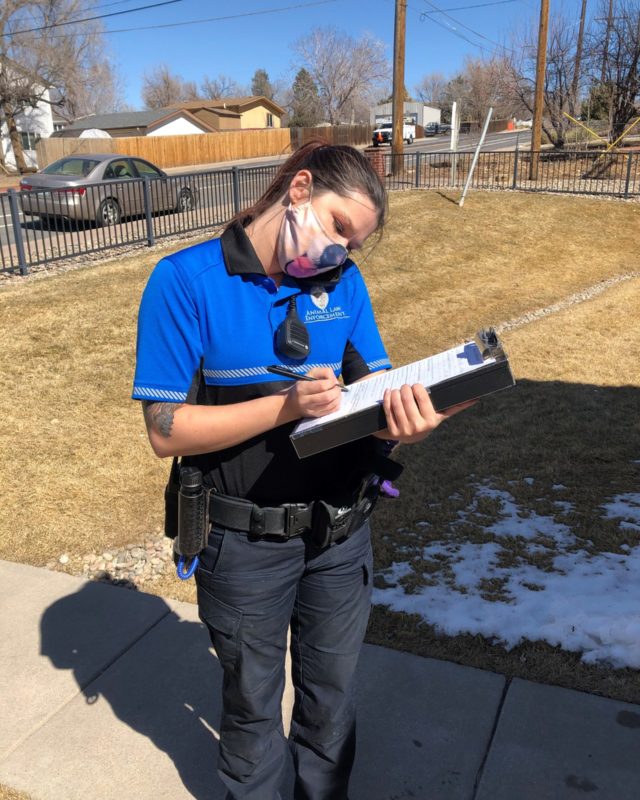
We arrive at our destination to check on the allegedly abandoned dogs. Corporal Ellis radios in and consults her notes via her truck laptop on the case. This is a follow-up, so another officer has been out to this location before but has not made contact with an owner. However, they did leave a notice of investigation on the door and left a neat little test so ALE can see if someone is coming by to check on the dogs. They stuck a very small piece of brightly colored paper in the door, so if the door opened, it would fall out. Corporal Ellis doesn’t see the notice of investigation or the paper test, so even though no one is answering the door, she can put in her notes for this follow-up that someone has been by to check on the dogs.
As we are leaving, we are approached by a neighbor, who has a few choice things to say about the people we are trying to contact.
“ALL. THE. TIME,” Corporal Ellis says, when asked how often ALE finds themselves involved in neighbor disputes. “I’ve had a situation where two neighbors don’t like each other, so they call us, they call CSPD, they call code enforcement just to battle back and forth. ‘Her dog is skinny, her dog needs vet care, they beat their dog.’ We have to respond every time to make sure the pet’s welfare is good. Most of the time, thankfully, it’s unfounded.”
Corporal Ellis drives to the parking lot of a nearby business for safety before putting in her notes about the case. Then, we’re off on our next call – another patrol for a dog at large. This one is a little further to the east. Corporal Ellis says she normally listens to audio books while on duty to pass the driving time. She’s a huge sci-fi nerd. She also loves noticing fun things about the city. “If you are looking to build a house, I have so many interesting things about houses to share!” she jokes.
As we drive, we talk about some of the other duties assigned to Animal Law Enforcement officers. Officers are required to testify in court, especially with aggressive animal cases and cruelty cases. They patrol the parks and trails around town to ensure leash laws are being followed. “There are so many parks around the city, even private parks,” Corporal Ellis says. “Just because you don’t see us doesn’t mean we aren’t out there.” Officers have special training to rescue trapped pets from dangerous situations. Officer Ellis herself has rescued animals from sewage drain tunnels, ditches, and even off I-25. Officers enforce licensing laws and do community events to help educate the public on the laws and how they can be responsible pet owners. They work closely with other enforcement agencies and work hand in hand with them on investigations, including local law enforcement, code enforcement, child protective services, adult protective services, and more.
Once again, no sign of the dog at large, and after performing our patrol, we check in and are on our way again. We’re two hours into our ride-along, and we have yet to see a single animal. But this next call is a report of an individual who has threatened to harm cats in his neighborhood.
Potential animal cruelty is only a percentage of what Corporal Ellis deals with on a daily basis, but she says it’s one of the hardest and most frustrating parts of her job.
“We get calls every day about hitting or kicking pets,” Corporal Ellis said. “The hardest thing is unless we have video or photos, unless the animal has injuries to prove it’s true, there’s not much we can do. We aren’t saying it didn’t happen, but we can’t prove to a court that it did. That’s the crappy part of this job, unless we have that proof, we don’t have probable cause to remove the dog or charge the owner. It’s very frustrating. My dog is my kid, but not everyone feels that way. We can’t be biased no matter how much we want to be. We can’t force people to love their animals.”
The other side of the cruelty coin is animal neglect, which Corporal Ellis faces all the time. Most people are trying to be the best pet parents they can be, but they might not have noticed or might not be educated about what is best for their pet. Or, they might not have the resources to give their pet the help they need. In those situations, Corporal Ellis does what she can to help get those families some help.
“We don’t want to be the bad guys,” she said. “We don’t want to take animals away. We want to give owners the opportunity to keep their pets and make things better.”
Corporal Ellis recalls fondly the dog she helped a few years ago named Oso. Oso and his owner were homeless, and Oso had an injured leg that was causing him a lot of pain. Corporal Ellis could have taken Oso away and charged his owner, but Oso was the only family the man had. Instead, she worked with Oso’s owner to get Oso the surgery and physical therapy he needed. About a year after she helped Oso, she ran into his owner yet again. Oso’s dad said that Corporal Ellis helped him get his life back on track. He had a job, a car, and an apartment for him and Oso, and it was all due to her kindness.
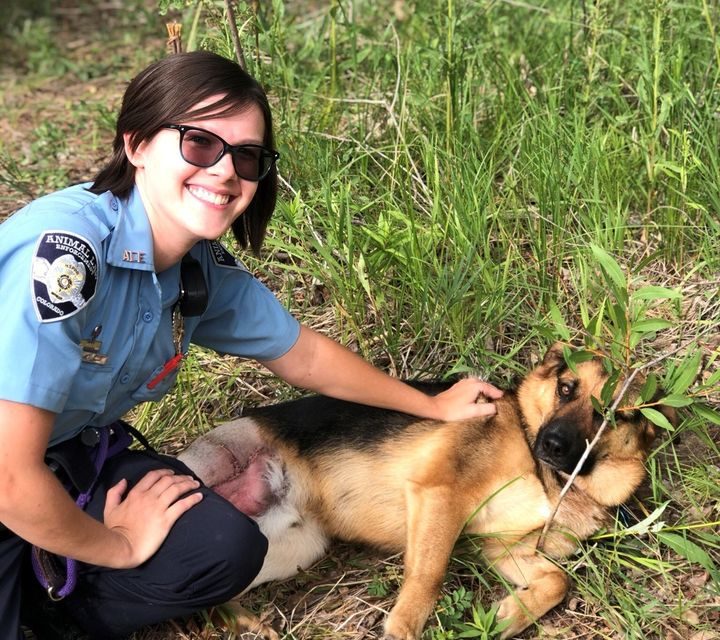
Corporal Ellis says she keeps a tub in the back of her truck with collars, leashes, blankets, food, and toys she gives out frequently to pet owners in need.
“A lot of the homeless take care of their animals better than they take care of themselves,” she said. “They just need that extra help or encouragement to get them through those tough times.”
We’re wrapping up our ride-along now, and on our way back to HSPPR, we see another one of Corporal Ellis’ friends. “It’s waving man!” she says excitedly, waving at a homeless-looking man with a sign who is waving enthusiastically at her. “He makes my day.”
As we turn into the parking lot of HSPPR, Corporal Ellis gives her last piece of wisdom for the day. “Always call us,” she says. “We are here to help.”
“The community is our eyes and ears,” she says. “We want to help, we want to make the situation better for you and your pets. Please give us a call, and let’s see what we can do together.”







